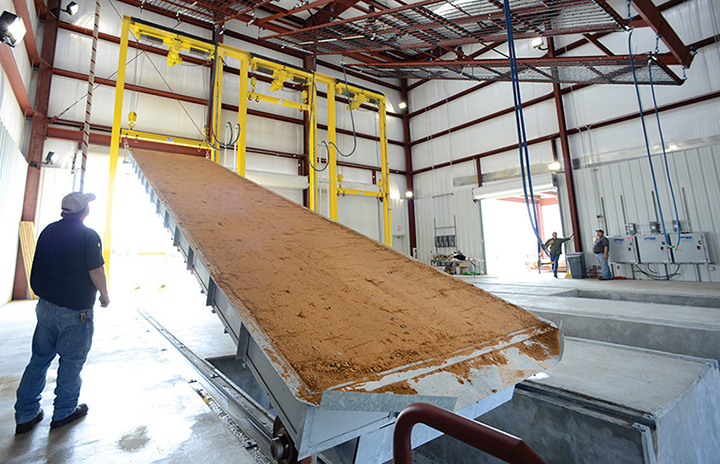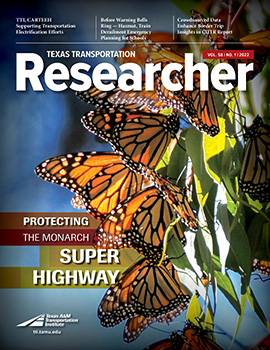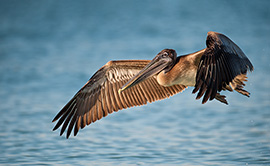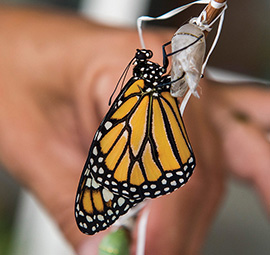The behavior of the brown pelican, the fascinating migration of monarch butterflies, and rangeland management are not usually associated with transportation research. But all that is changing. Over the last few years, researchers with the Texas A&M Transportation Institute (TTI) have developed a portfolio of environmental projects never considered part of transportation research.
TTI already has a rich history of environmental activities. For example, the Institute helps Texans breathe easier with its air quality research. And for 32 years, TTI’s Sediment and Erosion Control Laboratory has evaluated roadside products that help preserve waterways and groundwater.
Now, transportation research opportunities that have an environmental connection are becoming more common.

“The research landscape is certainly changing,” says Jolanda Prozzi, TTI’s Multimodal Planning and Environment division head. “We are conducting more and increasingly diverse environmentally focused projects.”
For example, TTI recently collaborated with Texas A&M AgriLife on Texas Department of Transportation (TxDOT)–funded monarch butterfly and Houston toad projects. “We are currently hosting experiments that look into the efficacy of fences to keep the endangered Houston toad away from work zones,” TTI Research Scientist Jett McFalls says. (See related article in this issue.) “It’s an extension of our expertise in silt and sediment fences but also presents exciting new opportunities to reduce the environmental footprint of transportation.”
The recent interest in monarchs is due to an impending decision by the U.S. Fish and Wildlife Service to list them as endangered, which would have important consequences for right-of-way management and roadway construction. There’s been an 80 percent decline in the number of these fascinating insects over the last two decades. If they are listed as an endangered species, transportation agencies across the country may need to adjust the management of their rights of way.
“TxDOT sponsored a project to estimate monarch roadkill within its migration corridors and identify ways of mitigating mortality,” says Prozzi. “The hope is that the research will help conserve monarchs such that they will not need to be listed or, worst case, will provide effective mitigation solutions should they become listed.”
TTI became involved in the project because of its work on right-of-way vegetation management (including work on Texas’s renowned wildflower program) and the management of rights of way for pollinator and monarch habitat.
TTI Assistant Research Scientist Andrew Birt is also deeply involved in TTI’s environmentally focused research. He just completed a multiyear TxDOT project that involved brown pelicans in South Texas, where the birds are being hit and killed by motorists during blistering cold fronts along the coast.
“Wildlife-oriented transportation problems such as those involving the monarch, brown pelican and Houston toad tend to be very diverse and can’t be solved until we understand the ecology and behavior of the focal species,” Birt points out. “But established transportation knowledge is also essential for solving these problems — and this makes TTI an ideal venue for this type of research.
Societal concerns about the environment have highlighted the need for more research on the impact of transportation. Transportation can also have a positive impact on the environment. Birt is currently participating in a U.S. Department of Agriculture–funded project to improve rangeland management. Rangelands are typically managed for cattle production, but they also provide essential ecosystem services such as water, wildlife, recreation and wildfire prevention. “Historically, transportation has benefited agricultural systems by allowing goods and services to be moved to and from markets, and by helping sustain rural communities. But trends in transportation and shifting attitudes toward the environment suggest that we revisit how transportation can help improve the efficiency and sustainability of agricultural systems such as rangelands.”
“The new Infrastructure Investment and Jobs Act specifically highlights wildlife crossings, rural communities, water conservation, wildfire, ecosystem restoration and resilience — all issues that we have already begun to research,” Prozzi adds.
“In line with this changing research landscape, we are developing new expertise within the division, as well as collaborating with other groups in TTI and environmental researchers in The Texas A&M University System.”


